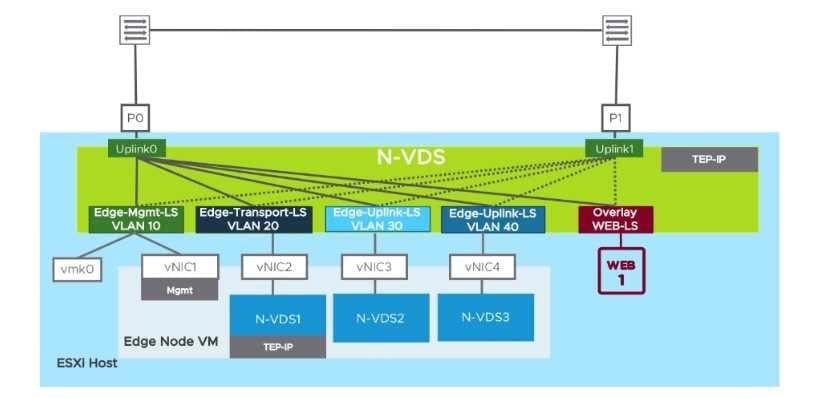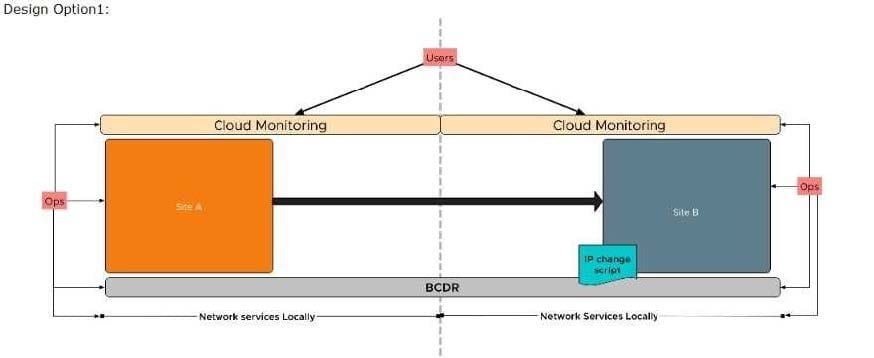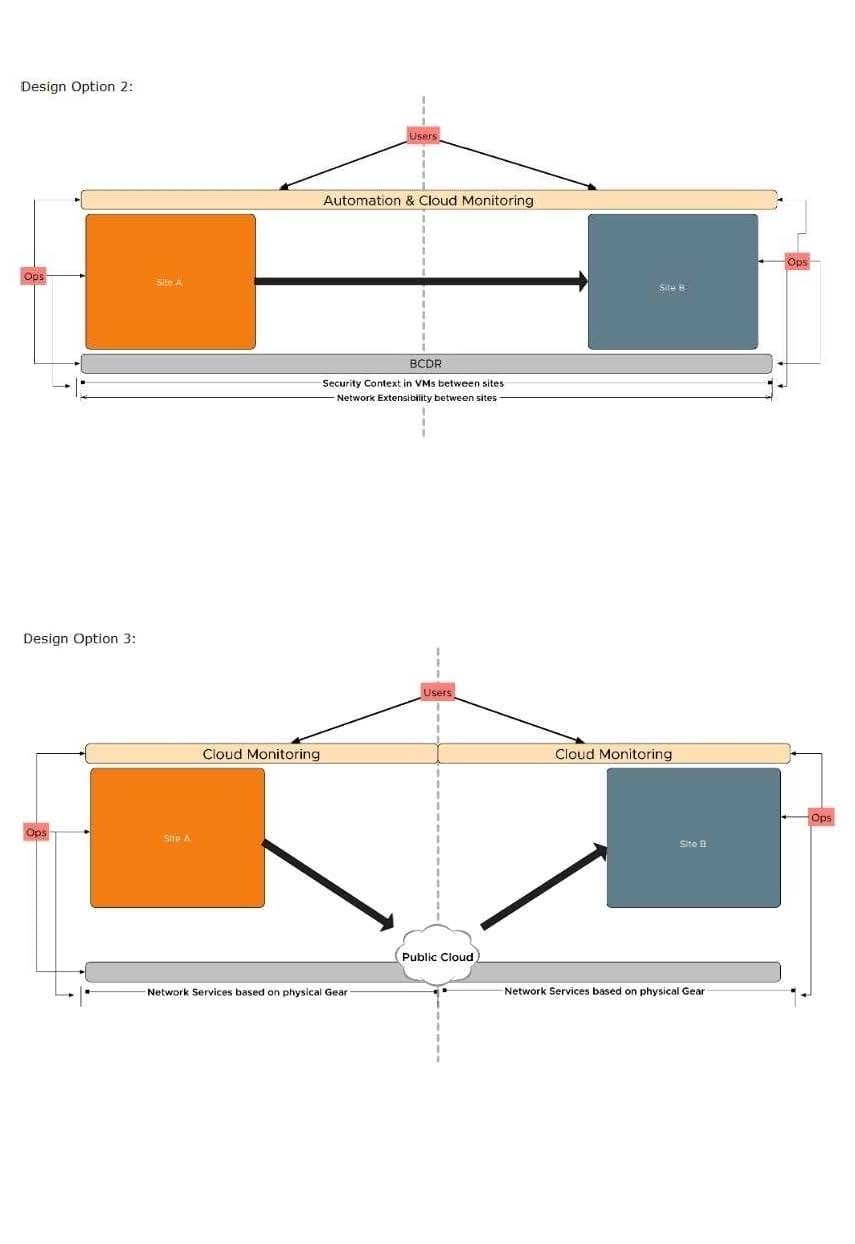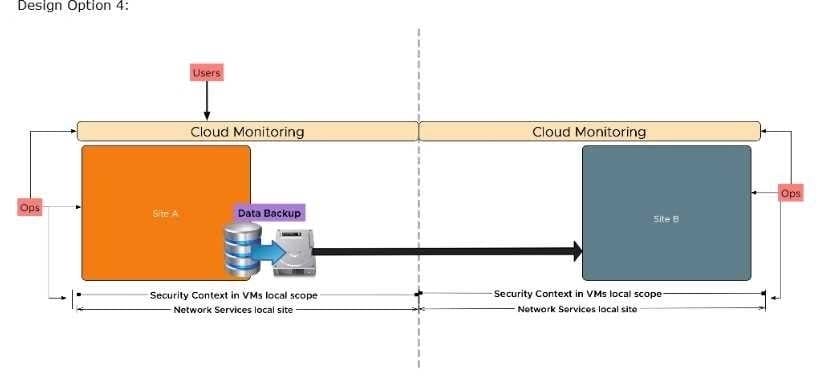Exam Details
Exam Code
:3V0-41.19Exam Name
:Advanced Design NSX-T Data Center 2.4Certification
:VMware CertificationsVendor
:VMwareTotal Questions
:50 Q&AsLast Updated
:Dec 22, 2024
VMware VMware Certifications 3V0-41.19 Questions & Answers
-
Question 1:
A customer wants to use ECMP to provide additional throughput and availability for their critical business applications. Some applications require load balancing for scale and availability. Which two Edge design choices can an architect present to the customer? (Choose two.)
A. Configure ECMP and Load Balancing on the Tier-0 gateway.
B. Create a Tier-0 gateway in Active/Standby mode and a Tier-1 gateway in Active/Standby mode.
C. Configure ECMP on the Tler-0 gateway and Load Balancing on the Tier-1 gateway.
D. Create a Tier-0 gateway in Active/Standby mode.
E. Configure ECMP on the Tier-1 gateway and Load Balancing on the Tier-1 gateway.
F. Create a Tier-0 gateway in Active/Active mode and a Tier-1 gateway in Active/Standby mode.
-
Question 2:
An architect is helping an organization with the Logical Design of an NSX-T Data Center solution. This information was gathered during the Assessment Phase:
1.
Any solution should add more value to current and future customers engagements.
2.
The solution should improve the company's operational efficiency.
3.
The design should offer agility and freedom for application phases.
4.
There should be improvement in application life cycle SLAs.
5.
Current physical solution is composed of many vendors taking care of many layers of security, but it is getting complex. A reduction in complexity will be something expected from any solution.
6.
Current business continuity and disaster recovery plans are based on tape technology. A public cloud class of service should be party of any new solution.
7.
Scripts are used for repeatable tasks in combination with many open source tools.
8.
Delays are Incurred with new marketing campaigns because an external IT services company must be hired. Campaigns must be accelerated with any new solution.
9.
All application servers have hardcoded IP addresses.
10.
Different vendors are used for our storage solution.
11.
The time line before an upcoming freeze period is soon.
Which two statements should the architect consider as non technical requirements? (Choose two.)
A. statement 4
B. statement 1
C. statement 11
D. statement 6
E. statement 9
-
Question 3:
A telecom company has purchased NSX-T as part of a software defined data center (SDDC) initiative. The company wants to ensure the highest performance for network traffic leaving the virtual environment. Which two selections would an architect recommend to achieve the customer's goal? (Choose two.)
A. Configure SR-IOV for the virtual NSX Edges.
B. Use physical NSX Edges with DPDK supported hardware.
C. Select Network cards that support VXLAN Offload.
D. Configure Equal-Cost Multi-Pathing on the NSX Edges.
E. Set "Latency Sensitive" option to High when deploying the virtual NSX Edges.
-
Question 4:
Which type of design includes vendor models, host names, IP Addresses, port connections, logical unit number sizes, and number of CPUs?
A. High-Level Design
B. Physical Design
C. Logical Design
D. Conceptual Design
-
Question 5:
An architect is helping an organization with the Logical Design of an NSX-T Data Center solution. This information was gathered during the Assessment Phase:
1.
Data between two networks connected over a public network needs to be encrypted.
2.
Certificate authentication is required.
3.
Dynamic route learning is preferred.
Which should the architect include in their design?
A. Deploy a Tler-0 gateway in Active/Active mode. Configure policy-based IPSec VPN with SHA256withRSA as the hash algorithm.
B. Deploy a Tler-0 gateway In Active/Active mode. Configure route-based IPSec VPN with SHA512wlthRSA as the hash algorithm.
C. Deploy a Tier-0 gateway in Active/Standby mode. Configure route-based IPSec VPN with SHA512withRSA as the hash algorithm.
D. Deploy a Tier-0 gateway in Active/Standby mode. Configure policy-based IPSec VPN with SHA256withRSA as the hash algorithm.
-
Question 6:
An architect is designing a solution for containerization. The solution will include high availability and
security using NSX-T Data Center. The architect plans to provide a basic required components list In the
Logical Design.
Which solution should the architect recommend?
A. 2 NSX Managers, 2 virtual NSX Edges, one Tier-0 gateway, BGP configuration and a static route
B. 3 NSX Managers, 1 virtual NSX Edge, one Tier-0 gateway and a static route and OSPF
C. 1 NSX Manager, 2 virtual NSX Edges, two Tier-0 gateways In Active/Active, BGP configuration
D. 3 NSX Managers, 2 virtual NSX Edges, two Tier-0 gateways in Active/Passive, BGP configuration
-
Question 7:
Refer to Exhibit.

To meet the technical requirements for NSX Edge VM, which two design choices are required to satisfy this architectural design. (Choose two.)
A. NSX Edge TEP and ESXi TEP need to be in different VLANs.
B. ESXi host should be prepared as a Transport Node and use VLAN backend segments to connect Edge Node Interfaces.
C. ESXi host must have more than 2 pNICs available to create another N-VDS. D NSX Edge should run as a physical device.
D. vmk ports need to be on VDS instead of N-VDS, with onepNIC for each virtual switch providing greater functionality.
-
Question 8:
According to the Discover Task of the Engagement Lifecycle, which statement would be classified as a risk?
A. To retain certification to provide financial services to end customers, PCI-DSS audits need to be passed.
B. A merger and acquisition process was recently completed and new company on-boarding is not completed.
C. Due to existing contracts and purchase agreements, the existing server hardware needs to be re- used.
D. Enough power and cooling capacity is available in each rack in the data center.
-
Question 9:
Which two VMware recommendations should an architect follow when configuring top of rack (ToR) switches in an NSX-T Data Center environment? (Choose two.)
A. Modify the Spanning Tree Protocol to increase the time to transition to the forwarding state.
B. Configure redundant physical switches to enhance availability.
C. Use only IPv4 addressing in all deployments.
D. Configure switch ports that connect to ESXi host manually as trunk ports.
E. Configure switch ports with a Dynamic Trunking Protocol.
-
Question 10:
Refer to the exhibits.
An architect is helping an organization with the Conceptual Design of an NSX-T Data Center solution. The
conceptual design includes these requirements, assumptions, constraints, and risks:
1.
Critical applications must run across sites without changing IP address.
2.
Business continuity and disaster recovery (BCDR) plans will leverage a second site running vSphere.
3.
RTO/RPO must be reduced for recovery of applications on secondary site.
4.
IT Teams require automation tools for configuration.
Which Conceptual Design would the architect recommend to the customer?



A. Design Option 3
B. Design Option 1
C. Design Option 2
D. Design Option 4
Related Exams:
1V0-21.20
Associate VMware Data Center Virtualization1V0-31.21
Associate VMware Cloud Management and Automation1V0-41.20
Associate VMware Network Virtualization1V0-61.21
Associate VMware Digital Workspace1V0-71.21
Associate VMware Application Modernization1V0-81.20
Associate VMware Security2V0-21.20
Professional VMware vSphere 7.x2V0-21.23
VMware vSphere 8.x Professional2V0-31.21
Professional VMware vRealize Automation 8.32V0-31.23
VMware Aria Automation 8.10 Professional
Tips on How to Prepare for the Exams
Nowadays, the certification exams become more and more important and required by more and more enterprises when applying for a job. But how to prepare for the exam effectively? How to prepare for the exam in a short time with less efforts? How to get a ideal result and how to find the most reliable resources? Here on Vcedump.com, you will find all the answers. Vcedump.com provide not only VMware exam questions, answers and explanations but also complete assistance on your exam preparation and certification application. If you are confused on your 3V0-41.19 exam preparations and VMware certification application, do not hesitate to visit our Vcedump.com to find your solutions here.